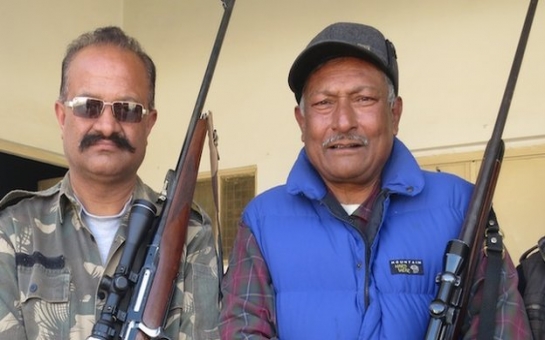On the trail of India's deadliest man-eating tiger for years, nerves are on edge - and reputations too.Hunter Ramesh Chauhan is pacing, well, like a caged animal.Team leader Ashish Dasgupta is out seeking new intelligence on the tiger that may have claimed 10 lives already.They are not even sure it is still alive: there's a rumour local Sikhs killed the tiger but are hushing it up.A week since they arrived, the hunters are getting frustrated.Latest victim"The cattle came back without him," says Vicky Singh, remembering the day his grandfather disappeared while grazing their water buffalo. Lal Singh, 65, was the tiger's last confirmed victim."Next morning I found his red and yellow turban, and then his legs and other body parts. I just collapsed."It's in the patchwork of sugarcane fields, forest and bush around Mr Singh's village in northern Uttar Pradesh that Mr Dasgupta and his team have been concentrating.A veteran of more than 40 hunts for big cats that have turned man-eater, he says this one has proved "particularly elusive" since it began its killing spree in late-December.One of its tactics has been to hide in the dense sugarcane and then pounce on unsuspecting labourers harvesting the crop."It can come out from anywhere and then disappear back inside," says Mr Dasgupta, keeping a hand on the Magnum pistol on his hip. "It's all over in seconds."A short drive away is India's largest tiger reserve, the Jim Corbett national park - named after a colonial-era hunter - set in the early foothills of the Himalayas.The park is home to as many as one in 10 of India's estimated 1,700 hard-pressed wild tigers, more than half the world's population. And it's thought the rogue tiger is from the reserve.But the initial attacks happened more than 100km (62 miles) away, far beyond a tiger's normal roaming range.Another surprise is what looks like an indecisive appetite. "It's only eating soft parts like the stomach and genitalia, not the whole body," he says. "It doesn't seem able to bite hard flesh or bone effectively."That may be a sign the animal is wounded or can't use its jaws properly. It may also be why it has turned on humans - much easier to catch, says Mr Dasgupta, than its usual prey of deer or other wild animals.But if the tiger is still alive, he is sure "it will kill again. The tiger has got the taste of human flesh now".Night-time huntAs night falls, the hunters hitch a powerful searchlight to their jeep's battery.All eyes are fixed on the sharp disc of light as it jumps and bounces over the landscape."Look, look, look," Mr Dasgupta whispers suddenly as they cross a river-bed, already levelling his rifle.Out in the gloom, the beam has lit up a pair of eyes.The two glinting specks start to run and Mr Dasgupta follows with his telescopic sight.But then he lowers the gun. "Jackal," he sighs."We're living in terror now," Vicky Singh complains, back in Sahuwala village. They are no longer taking their buffalo out to graze, but feeding them in their stables."Even if a leaf shakes on a tree, we think it's a tiger. They have got to kill it."With tigers under constant pressure, some conservationists have called for it to be tranquillised if it's found - especially as there has been speculation it is a rare female.But struggling to find enough workers to gather his sugarcane crop, local farmer Shahid Hussein says it is too late for that: "We live with the tigers. We don't mind them eating our animals occasionally, but we can't accept it turning on men and women."Mr Dasgupta scoffs at the idea of tranquillising it, because the effect is not instantaneous, giving the tiger time to escape or attack. And the authorities have given him a licence to kill.There is no reward, but the prize is unquantifiable: being the name in the hunting fraternity who bagged a serial man-eater and a trophy photograph with the big killer cat.Mr Dasgupta has a large collection, including photos of India's biggest ever man-eating leopard, which he shot in 2000 - "one inch longer than Jim Corbett's record," he smiles.For all his team, this is passion rather than profession. Mr Dasgupta is an industrialist who makes shock absorbers, his friend Ramesh a politician in the ruling Congress party. The two other regulars in this band of shooters are a pharmacist and property dealer.While the state authorities have been employing tiny drones to search for the tiger, it is amateurs who dominate the effort. Some are using elephants; others sitting in hides watching baited traps.But there's been little coordination or sharing of information.Nerves of steelIn the distance, the hills of the Corbett tiger reserve are turning orange and another day is slipping away without a firm lead.Mr Dasgupta has driven off to meet the local forest ranger.The man from the Congress party sits down on a rope bed. "We're all non-veg," says Chauhan. "We hardly ever shoot a wild animal. We protect them. But we're sportsmen too. And sportsmen don't like to be idle."Someone suggests it is time to get out of the jeep more."I like to hunt tigers on foot," Mr Dasgupta had said a few days earlier. "But you need nerves of steel."Mr Chauhan is not impressed. Most people would think twice about jumping into the undergrowth after a tiger.The only thing that's certain is that the competition is stiffening.Desperate to find the tiger after more than seven weeks of attacks, the state authorities have called in more hunters.The secret, says Mr Dasgupta, is "to think like a tiger, think like a predator".And next morning they find a lead - fresh tiger tracks, right next to Shahid Hussein's sugarcane fields. They make plaster casts of the footprints and now they are waiting to compare them with others taken from the site of a recent kill.Mr Dasgupta walks into the undergrowth nearby, pulling out his handgun, a half-smoked "beedi" - a small hand-rolled cigarette common in India - butt wedged in his mouth."The human-animal conflict" is only likely to intensify, he says, with humans constantly encroaching on tiger habitat."If you take away someone's home, what do they do? They walk the streets. They become a hobo."(BBC)ANN.Az
Hunting for India's deadliest man-eating tiger
World
19:17 | 27.02.2014

Hunting for India's deadliest man-eating tiger
"Dasgupta can do what he likes. I'm not going into the bush on foot."
Follow us !










